
The First Annual Convention of the Bahá'ís of North East Asia, held at Gakushi Kaikan in Tokyo, Japan, 1957. Hands of the Cause Miss Alexander and Mr. Khazeh are holding the frame containing the "Greatest Name."

The first National Spiritual Assembly of the Bahá'ís of North East Asia, 1957. Seated: Mr. Noureddin Mumtazi, Hand of the Cause Miss Agnes Alexander, Mrs. Barbara R. Sims and Mr. Hiroyasu Takano. Standing: Mr. Ataullah Moghbel, Mr. Michitoshi Zenimoto, Mr. Philip Marangella, Mr. Yadollah Rafaat and Mr. William Maxwell.
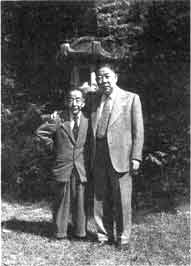
This classic photograph was taken during the Nikko Conference in 1955. Mr. Fujita (left), the second Japanese to become a Bahá'í, and Mr. Seto, the one of the first Bahá'ís of American-Chinese ancestry.

Mrs. Mamie Seto (far right) visits her husband's grave in Yokohama about 1961. On the left is Mr. Philip Marangella, next Mrs. Akiko Schreiber (her husband Eugene was the photographer), and Mrs. Sims.

Among the early teaching conferences in Japan was this one in Kyoto in September 1956. Fifty-eight adults and fifteen children attended. A greeting was sent to the Guardian, Shoghi Effendi. His answering cable was: "Deeply appreciate message. Welcome renewed dedication. Fervently supplicating great victories."
About half of the attendants were Japanese, the rest were American and Persian pioneers. Most of the children were Persian.
Miss Alexander is sitting in the second row, second from the left, between Mrs. Torii and Mrs. MacDonald.
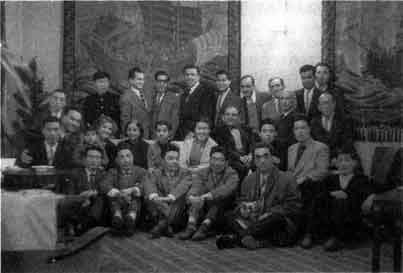
The first regular Bahá'í meetings in Osaka were held in a hotel such as this. This meeting was either in 1956 or 1957. There are about twelve Persians in the photo. They were working very hard to establish the Faith in the Kansai area. Mr. Marangella is sitting third from the right, middle. He was often the speaker at such gatherings.
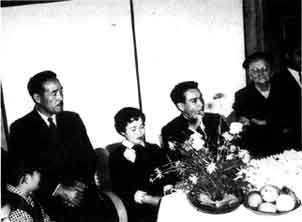
At the wedding party of Mr. and Mrs. Michitoshi Zenimoto, at the Amagasaki Bahá'í Center, January 1956. To the left is Mr. Zenimoto's father. To the right is Miss Alexander.

World Religion Day meeting in Tokyo, 1952. About thirty people attended. Miss Alexander is speaking with Mr. Hongo translating.

Conference of World Religionists, August 1955. Three Bahá'ís attending various sessions are seen in this newspaper clipping. Mr. Marangella is in the middle, Dr. Earl, seen in profile, and Miss Alexander.
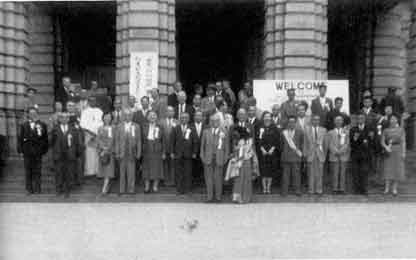
International Congress of World Fellowship of Faiths, Tokyo, October 1956. Miss Alexander is in the first row a little to the left. Several other Bahá'ís can be seen also. The photograph was taken after the second session.
This building, fashioned after the Palace of Versailles, was later closed to general public gatherings and reserved for Heads of State.

The 12th National Conference for the Blind, Matsue, 1959. Miss Alexander is speaking with Mr. Torii translating.
Regarding that particular trip to Matsue, Miss Alexander wrote, "In Matsue City, the 12th Annual Conference of the Blind Association was held. Through our brother, Mr. Tokujiro Torii, who is president of the Blind Association, I was given the privilege of speaking at the close of the conference for three minutes. It was translated into Japanese. Four hundred representatives from forty-six prefectures were present.
"The time was short but after every translation there was tremendous applause."
Miss Alexander stated that she had known Mr. Torii for forty years; that she was a Bahá'í; that the sight of the eyes was not the most important, but the sight of the heart was the all important; that everyone longed for peace but it could only come through the spiritual unity of all people.
While she was speaking she noticed that a man holding bright lights was standing in front of them. It was NHK (Nihon Hoso Kyokai) Television Network. Miss Alexander stated, "This was shown throughout Japan giving prominence to the Faith."
It was the second time the Faith was mentioned on television.

This photograph was in Miss Alexander's effects. She did not label it, so we do not know the occasion. However, it seems rather typical. Miss Alexander often accompanied Mr. and Mrs. Torii to both Esperanto and Blind Association conferences.
In both types of events she was usually able to speak publicly, in English or Esperanto, with Mr. Torii translating. This photograph was taken during one such conference, probably one of the Blind Association in the late 1950s or early 1960s. In those early days foreigners were somewhat of a novelty in Japan and Miss Alexander often attracted attention and people listened to what she had to say.
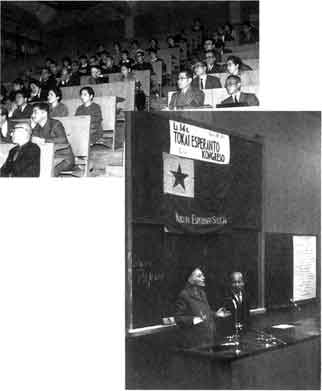
Esperanto Congress in Nagoya, May 1965. In the top photograph Miss Alexander is seen sitting among the participants. In the bottom one she is speaking to the Congress. An old friend, Mr. Kataoka is translating.
Miss Alexander stayed as active as possible in Esperanto activities even through the later years. She felt that Esperantists were particularly receptive to the Faith.
This was the last Esperanto Congress she was able to attend. She came to Tokyo two months later to attend another one but before it opened she fell and broke her hip. She was hospitalized from then on.

World Conference on Religion and Peace, Kyoto, October 1970. This photograph shows the Bahá'í representatives at the conference: Mrs. Shirin Fozdar, Mr. Glenford Mitchell, Dr. Toshio Suzuki and Mr. Rouhollah Mumtazi.
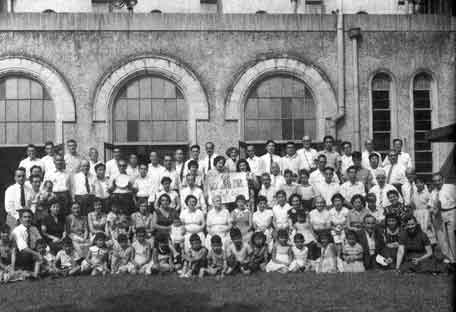
The cable sent to the Guardian from the Summer School reported that there were one hundred attendants in all, representing sixteen cities. The Guardian answered by cable: "Congratulate attendants historic summer school fervently praying expansion valued activities, love, Shoghi"
Hand of the Cause Miss Alexander is sitting under the banner. Mr. Carl Scherer, Auxiliary Board Member from Macau is standing, back row, middle of the right side. In this photograph we can see thirty-six Japanese, twenty-four Persians, including one youth, seven Americans, including one youth and twenty-one children, Persian and Japanese.
| Traces that Remain table of contents History of the Bahá'í Faith in East Asia main page Bahá'í Academics Resource Library |